Professional IT Culture: SFIA and Ethical Dilemmas
VerifiedAdded on 2021/05/30
|11
|2032
|25
Report
AI Summary
This report provides an in-depth analysis of professional IT culture, examining the SFIA (Skills Framework for the Information Age) 6 framework and its application to IT-related problems. The report highlights the seven SFIA 6 responsibility levels and their relevance to personal career development. It explores the framework's use in managing professional IT competencies, reducing risks in IT projects, and assessing workforce skills. The second part of the report focuses on an ethical analysis of a case study involving ICvendor Pty Ltd, addressing ethical dilemmas faced by stakeholders, proposing ethical responses, and applying the ACS code of professional conduct. The report discusses the consequences of failing to apply ethical decision-making and explores relevant ethical theories. The report emphasizes the importance of ethical conduct and professional development within the IT industry.
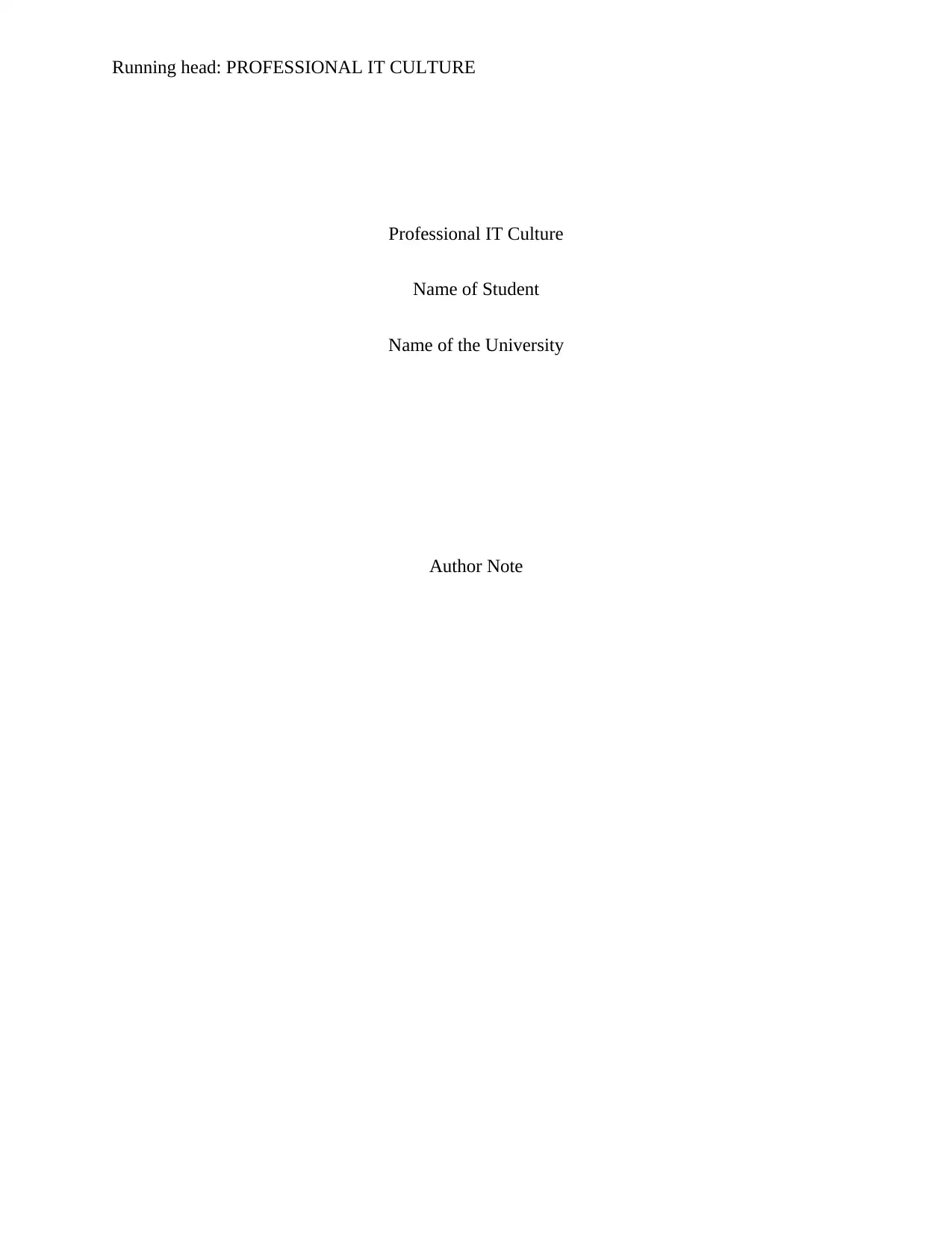
Running head: PROFESSIONAL IT CULTURE
Professional IT Culture
Name of Student
Name of the University
Author Note
Professional IT Culture
Name of Student
Name of the University
Author Note
Paraphrase This Document
Need a fresh take? Get an instant paraphrase of this document with our AI Paraphraser
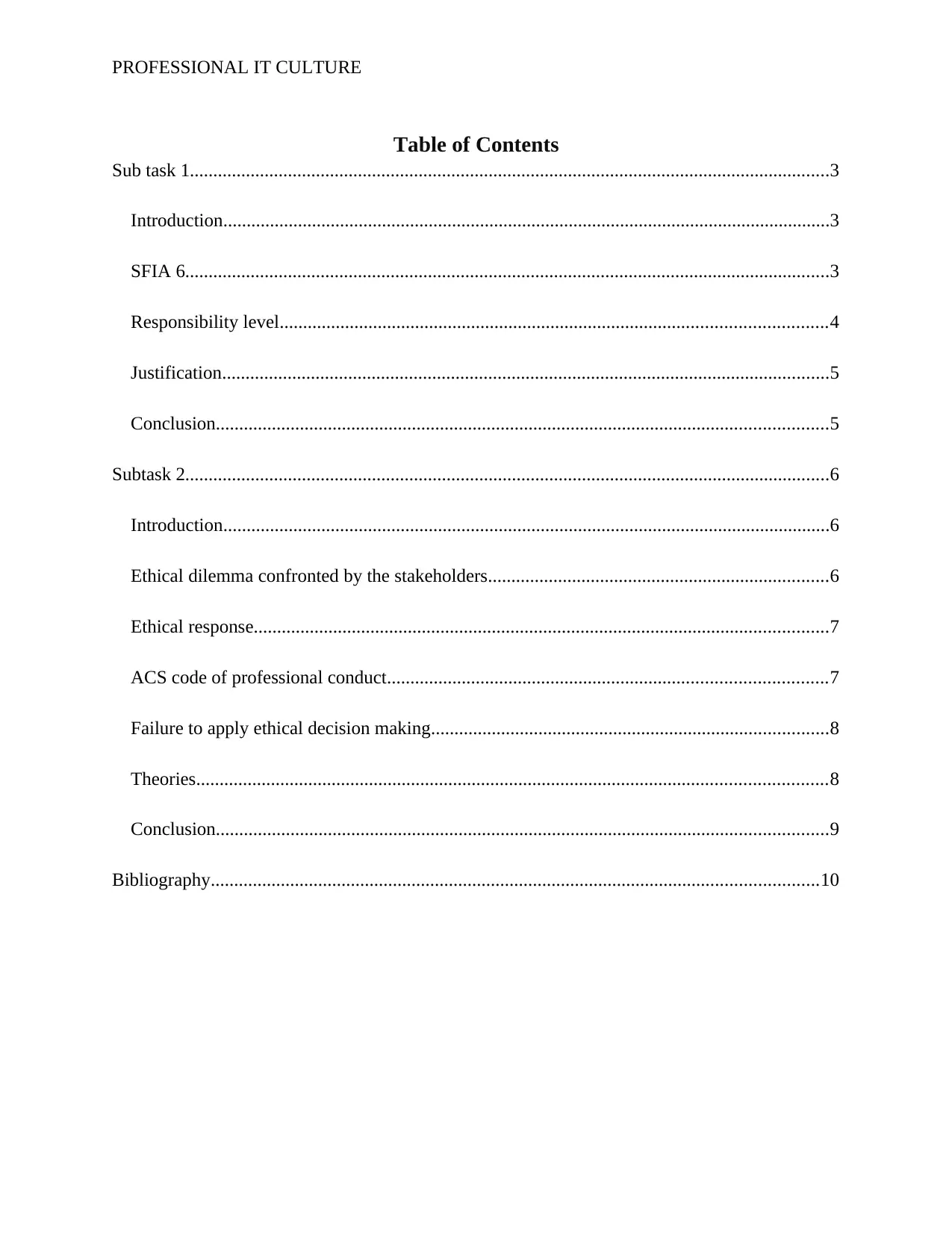
PROFESSIONAL IT CULTURE
Table of Contents
Sub task 1.........................................................................................................................................3
Introduction..................................................................................................................................3
SFIA 6..........................................................................................................................................3
Responsibility level.....................................................................................................................4
Justification..................................................................................................................................5
Conclusion...................................................................................................................................5
Subtask 2..........................................................................................................................................6
Introduction..................................................................................................................................6
Ethical dilemma confronted by the stakeholders.........................................................................6
Ethical response...........................................................................................................................7
ACS code of professional conduct..............................................................................................7
Failure to apply ethical decision making.....................................................................................8
Theories.......................................................................................................................................8
Conclusion...................................................................................................................................9
Bibliography..................................................................................................................................10
Table of Contents
Sub task 1.........................................................................................................................................3
Introduction..................................................................................................................................3
SFIA 6..........................................................................................................................................3
Responsibility level.....................................................................................................................4
Justification..................................................................................................................................5
Conclusion...................................................................................................................................5
Subtask 2..........................................................................................................................................6
Introduction..................................................................................................................................6
Ethical dilemma confronted by the stakeholders.........................................................................6
Ethical response...........................................................................................................................7
ACS code of professional conduct..............................................................................................7
Failure to apply ethical decision making.....................................................................................8
Theories.......................................................................................................................................8
Conclusion...................................................................................................................................9
Bibliography..................................................................................................................................10

PROFESSIONAL IT CULTURE
Sub task 1
Executive Summary
This paper focuses on the investigation over the SFIA (Skills Framework of the
Information Age) 6 framework, and applying the theoretical knowledge on the IT related
problems within an organization. This paper will be highlighting the seven SFIA 6 responsibility
levels that will be reflecting on the personal career development plan. This framework can be
applied in the business for managing the professional IT competencies, reducing the risks in the
IT projects, and simplifying the assessment of the IT skills of the workforce in manner to meet
the needs and requirements of the business.
Introduction
SFIA 6 can be described as the internationally recognized and standardized framework
that can be helpful in recognizing the framework that can be helpful in defining and stating the
skills, IT roles and levels of the skills necessary for solving IT problems. This framework is
helpful in describing the levels for each skills that is being accomplished through mixing level
description, skills description, and generic responsibilities. This framework allows the
individuals in recognizing the generic attributes for the levels and could be identified explicitly.
This framework has seven levels of the responsibility that makes the framework eligible to be
practiced in the real life.
SFIA 6
It is a model that is helpful in managing and describing the competencies those are
involved in the new era of the ICT professionalism that can be utilized in the business in manner
to fulfill the needs and requirements of the individuals. This framework has been divided in
Sub task 1
Executive Summary
This paper focuses on the investigation over the SFIA (Skills Framework of the
Information Age) 6 framework, and applying the theoretical knowledge on the IT related
problems within an organization. This paper will be highlighting the seven SFIA 6 responsibility
levels that will be reflecting on the personal career development plan. This framework can be
applied in the business for managing the professional IT competencies, reducing the risks in the
IT projects, and simplifying the assessment of the IT skills of the workforce in manner to meet
the needs and requirements of the business.
Introduction
SFIA 6 can be described as the internationally recognized and standardized framework
that can be helpful in recognizing the framework that can be helpful in defining and stating the
skills, IT roles and levels of the skills necessary for solving IT problems. This framework is
helpful in describing the levels for each skills that is being accomplished through mixing level
description, skills description, and generic responsibilities. This framework allows the
individuals in recognizing the generic attributes for the levels and could be identified explicitly.
This framework has seven levels of the responsibility that makes the framework eligible to be
practiced in the real life.
SFIA 6
It is a model that is helpful in managing and describing the competencies those are
involved in the new era of the ICT professionalism that can be utilized in the business in manner
to fulfill the needs and requirements of the individuals. This framework has been divided in
⊘ This is a preview!⊘
Do you want full access?
Subscribe today to unlock all pages.

Trusted by 1+ million students worldwide

PROFESSIONAL IT CULTURE
different categories and responsibility level including six major areas: Delivery and Operation,
Change and Transformation, Development and Implementation, Relationships and Engagement,
Strategy and Architecture, and Skills and Quality those have been further divided in 97 separate
sub-categories. The framework is composed of seven levels responsibility levels including
“Follow, Assist, Apply, Enable, Ensure and advise, Initiate and influence, and Set strategy, and
Inspire and Mobilize.” These responsibility levels can be represented through generic description
describing the level of “autonomy, influence, complexity, and business skills required” those
have been described as below:
Responsibility level
Autonomy: It provides the authority of all the aspects related to the significant work at
the highest organizational level including the application and policy formation. It has been
completely accountable for the decisions made and actions taken by others and self who has been
assigned with the responsibility within the ongoing operational activity.
Influence: This level provides the individual with an authority to execute the decision-
makings those can be contributed in the critical success. The framework influences the
development and inspires the organization within the industries at maximum level. It is also
helpful in advancing the exploitation or / and knowledge of the technology in more than a single
organization or one organization. It also contributes in the development of the strategic
relationships among the government, industry leaders, partners, and customers concerning long-
term establishment.
Complexity: It is helpful in leading the implementation and formulation of the strategy
through applying the maximum level of the managerial and leadership skills. It also contributed
different categories and responsibility level including six major areas: Delivery and Operation,
Change and Transformation, Development and Implementation, Relationships and Engagement,
Strategy and Architecture, and Skills and Quality those have been further divided in 97 separate
sub-categories. The framework is composed of seven levels responsibility levels including
“Follow, Assist, Apply, Enable, Ensure and advise, Initiate and influence, and Set strategy, and
Inspire and Mobilize.” These responsibility levels can be represented through generic description
describing the level of “autonomy, influence, complexity, and business skills required” those
have been described as below:
Responsibility level
Autonomy: It provides the authority of all the aspects related to the significant work at
the highest organizational level including the application and policy formation. It has been
completely accountable for the decisions made and actions taken by others and self who has been
assigned with the responsibility within the ongoing operational activity.
Influence: This level provides the individual with an authority to execute the decision-
makings those can be contributed in the critical success. The framework influences the
development and inspires the organization within the industries at maximum level. It is also
helpful in advancing the exploitation or / and knowledge of the technology in more than a single
organization or one organization. It also contributes in the development of the strategic
relationships among the government, industry leaders, partners, and customers concerning long-
term establishment.
Complexity: It is helpful in leading the implementation and formulation of the strategy
through applying the maximum level of the managerial and leadership skills. It also contributed
Paraphrase This Document
Need a fresh take? Get an instant paraphrase of this document with our AI Paraphraser
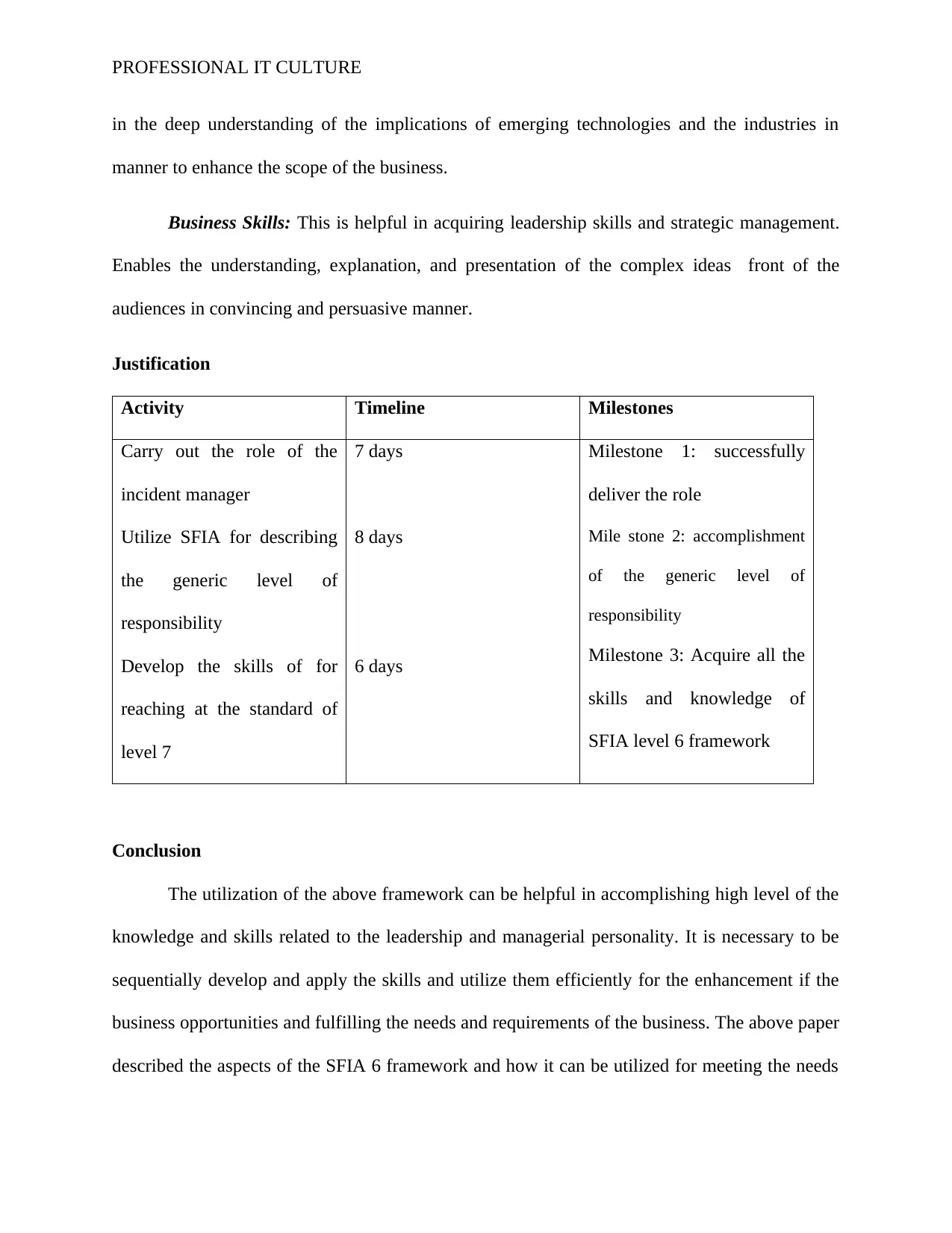
PROFESSIONAL IT CULTURE
in the deep understanding of the implications of emerging technologies and the industries in
manner to enhance the scope of the business.
Business Skills: This is helpful in acquiring leadership skills and strategic management.
Enables the understanding, explanation, and presentation of the complex ideas front of the
audiences in convincing and persuasive manner.
Justification
Activity Timeline Milestones
Carry out the role of the
incident manager
Utilize SFIA for describing
the generic level of
responsibility
Develop the skills of for
reaching at the standard of
level 7
7 days
8 days
6 days
Milestone 1: successfully
deliver the role
Mile stone 2: accomplishment
of the generic level of
responsibility
Milestone 3: Acquire all the
skills and knowledge of
SFIA level 6 framework
Conclusion
The utilization of the above framework can be helpful in accomplishing high level of the
knowledge and skills related to the leadership and managerial personality. It is necessary to be
sequentially develop and apply the skills and utilize them efficiently for the enhancement if the
business opportunities and fulfilling the needs and requirements of the business. The above paper
described the aspects of the SFIA 6 framework and how it can be utilized for meeting the needs
in the deep understanding of the implications of emerging technologies and the industries in
manner to enhance the scope of the business.
Business Skills: This is helpful in acquiring leadership skills and strategic management.
Enables the understanding, explanation, and presentation of the complex ideas front of the
audiences in convincing and persuasive manner.
Justification
Activity Timeline Milestones
Carry out the role of the
incident manager
Utilize SFIA for describing
the generic level of
responsibility
Develop the skills of for
reaching at the standard of
level 7
7 days
8 days
6 days
Milestone 1: successfully
deliver the role
Mile stone 2: accomplishment
of the generic level of
responsibility
Milestone 3: Acquire all the
skills and knowledge of
SFIA level 6 framework
Conclusion
The utilization of the above framework can be helpful in accomplishing high level of the
knowledge and skills related to the leadership and managerial personality. It is necessary to be
sequentially develop and apply the skills and utilize them efficiently for the enhancement if the
business opportunities and fulfilling the needs and requirements of the business. The above paper
described the aspects of the SFIA 6 framework and how it can be utilized for meeting the needs
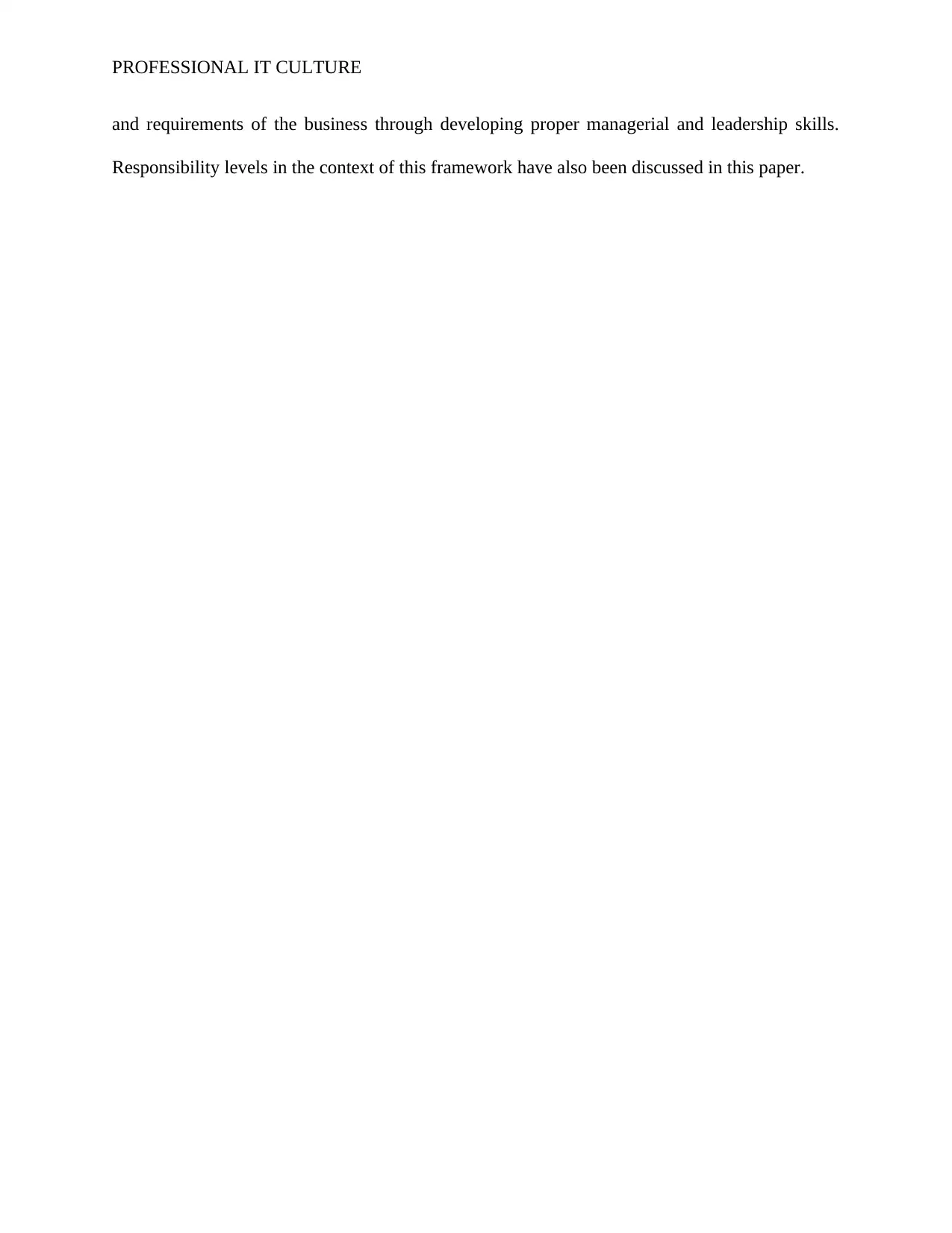
PROFESSIONAL IT CULTURE
and requirements of the business through developing proper managerial and leadership skills.
Responsibility levels in the context of this framework have also been discussed in this paper.
and requirements of the business through developing proper managerial and leadership skills.
Responsibility levels in the context of this framework have also been discussed in this paper.
⊘ This is a preview!⊘
Do you want full access?
Subscribe today to unlock all pages.

Trusted by 1+ million students worldwide
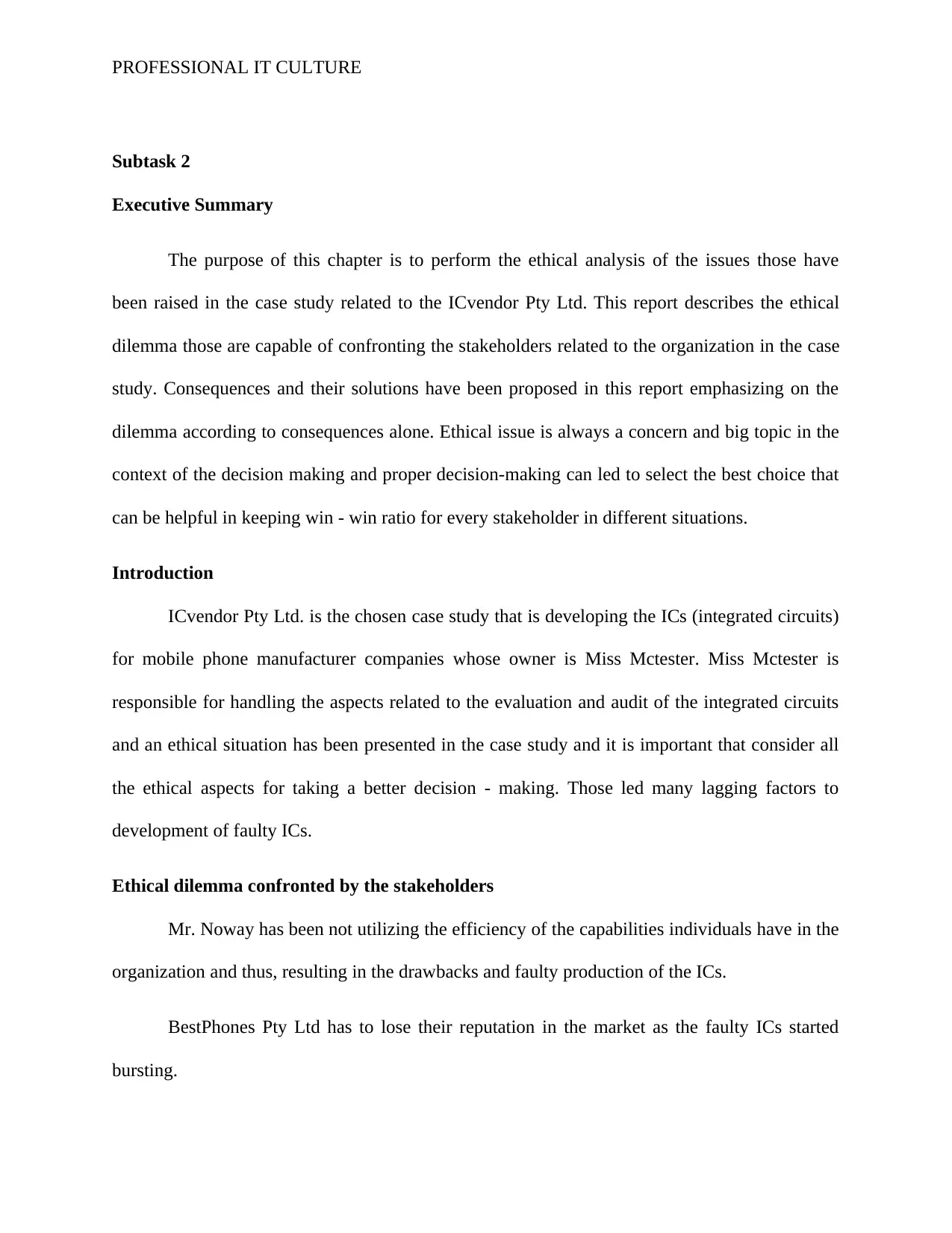
PROFESSIONAL IT CULTURE
Subtask 2
Executive Summary
The purpose of this chapter is to perform the ethical analysis of the issues those have
been raised in the case study related to the ICvendor Pty Ltd. This report describes the ethical
dilemma those are capable of confronting the stakeholders related to the organization in the case
study. Consequences and their solutions have been proposed in this report emphasizing on the
dilemma according to consequences alone. Ethical issue is always a concern and big topic in the
context of the decision making and proper decision-making can led to select the best choice that
can be helpful in keeping win - win ratio for every stakeholder in different situations.
Introduction
ICvendor Pty Ltd. is the chosen case study that is developing the ICs (integrated circuits)
for mobile phone manufacturer companies whose owner is Miss Mctester. Miss Mctester is
responsible for handling the aspects related to the evaluation and audit of the integrated circuits
and an ethical situation has been presented in the case study and it is important that consider all
the ethical aspects for taking a better decision - making. Those led many lagging factors to
development of faulty ICs.
Ethical dilemma confronted by the stakeholders
Mr. Noway has been not utilizing the efficiency of the capabilities individuals have in the
organization and thus, resulting in the drawbacks and faulty production of the ICs.
BestPhones Pty Ltd has to lose their reputation in the market as the faulty ICs started
bursting.
Subtask 2
Executive Summary
The purpose of this chapter is to perform the ethical analysis of the issues those have
been raised in the case study related to the ICvendor Pty Ltd. This report describes the ethical
dilemma those are capable of confronting the stakeholders related to the organization in the case
study. Consequences and their solutions have been proposed in this report emphasizing on the
dilemma according to consequences alone. Ethical issue is always a concern and big topic in the
context of the decision making and proper decision-making can led to select the best choice that
can be helpful in keeping win - win ratio for every stakeholder in different situations.
Introduction
ICvendor Pty Ltd. is the chosen case study that is developing the ICs (integrated circuits)
for mobile phone manufacturer companies whose owner is Miss Mctester. Miss Mctester is
responsible for handling the aspects related to the evaluation and audit of the integrated circuits
and an ethical situation has been presented in the case study and it is important that consider all
the ethical aspects for taking a better decision - making. Those led many lagging factors to
development of faulty ICs.
Ethical dilemma confronted by the stakeholders
Mr. Noway has been not utilizing the efficiency of the capabilities individuals have in the
organization and thus, resulting in the drawbacks and faulty production of the ICs.
BestPhones Pty Ltd has to lose their reputation in the market as the faulty ICs started
bursting.
Paraphrase This Document
Need a fresh take? Get an instant paraphrase of this document with our AI Paraphraser
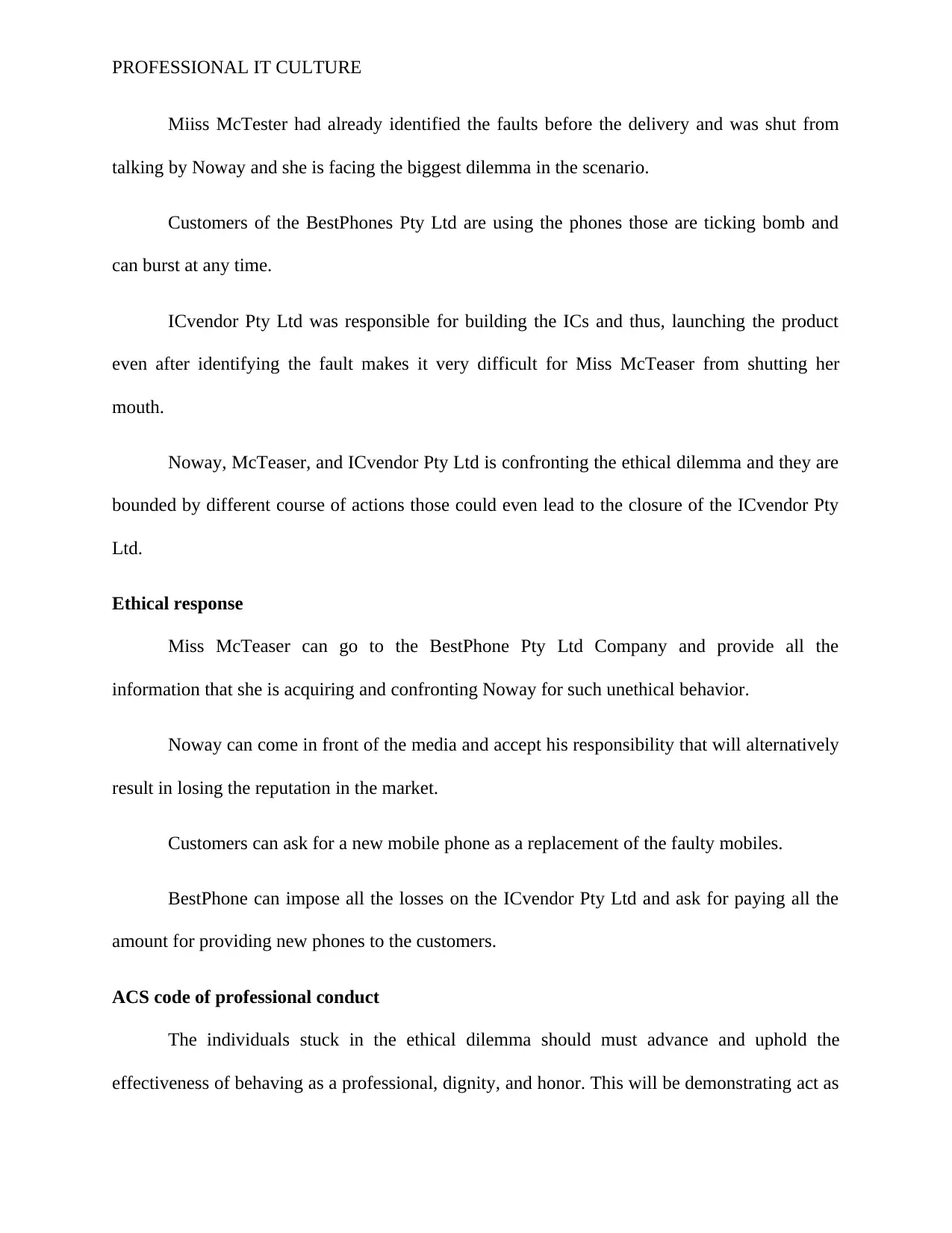
PROFESSIONAL IT CULTURE
Miiss McTester had already identified the faults before the delivery and was shut from
talking by Noway and she is facing the biggest dilemma in the scenario.
Customers of the BestPhones Pty Ltd are using the phones those are ticking bomb and
can burst at any time.
ICvendor Pty Ltd was responsible for building the ICs and thus, launching the product
even after identifying the fault makes it very difficult for Miss McTeaser from shutting her
mouth.
Noway, McTeaser, and ICvendor Pty Ltd is confronting the ethical dilemma and they are
bounded by different course of actions those could even lead to the closure of the ICvendor Pty
Ltd.
Ethical response
Miss McTeaser can go to the BestPhone Pty Ltd Company and provide all the
information that she is acquiring and confronting Noway for such unethical behavior.
Noway can come in front of the media and accept his responsibility that will alternatively
result in losing the reputation in the market.
Customers can ask for a new mobile phone as a replacement of the faulty mobiles.
BestPhone can impose all the losses on the ICvendor Pty Ltd and ask for paying all the
amount for providing new phones to the customers.
ACS code of professional conduct
The individuals stuck in the ethical dilemma should must advance and uphold the
effectiveness of behaving as a professional, dignity, and honor. This will be demonstrating act as
Miiss McTester had already identified the faults before the delivery and was shut from
talking by Noway and she is facing the biggest dilemma in the scenario.
Customers of the BestPhones Pty Ltd are using the phones those are ticking bomb and
can burst at any time.
ICvendor Pty Ltd was responsible for building the ICs and thus, launching the product
even after identifying the fault makes it very difficult for Miss McTeaser from shutting her
mouth.
Noway, McTeaser, and ICvendor Pty Ltd is confronting the ethical dilemma and they are
bounded by different course of actions those could even lead to the closure of the ICvendor Pty
Ltd.
Ethical response
Miss McTeaser can go to the BestPhone Pty Ltd Company and provide all the
information that she is acquiring and confronting Noway for such unethical behavior.
Noway can come in front of the media and accept his responsibility that will alternatively
result in losing the reputation in the market.
Customers can ask for a new mobile phone as a replacement of the faulty mobiles.
BestPhone can impose all the losses on the ICvendor Pty Ltd and ask for paying all the
amount for providing new phones to the customers.
ACS code of professional conduct
The individuals stuck in the ethical dilemma should must advance and uphold the
effectiveness of behaving as a professional, dignity, and honor. This will be demonstrating act as
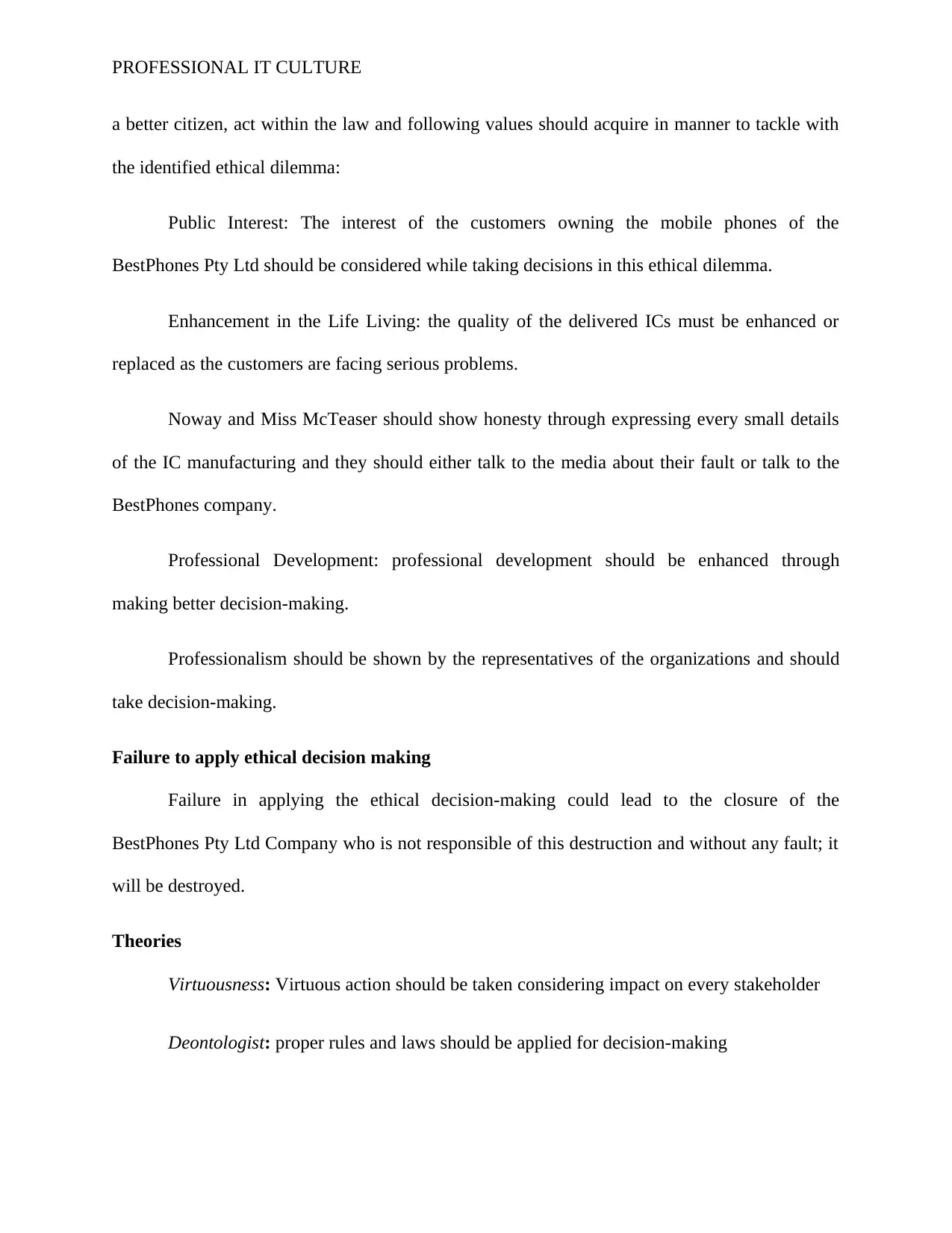
PROFESSIONAL IT CULTURE
a better citizen, act within the law and following values should acquire in manner to tackle with
the identified ethical dilemma:
Public Interest: The interest of the customers owning the mobile phones of the
BestPhones Pty Ltd should be considered while taking decisions in this ethical dilemma.
Enhancement in the Life Living: the quality of the delivered ICs must be enhanced or
replaced as the customers are facing serious problems.
Noway and Miss McTeaser should show honesty through expressing every small details
of the IC manufacturing and they should either talk to the media about their fault or talk to the
BestPhones company.
Professional Development: professional development should be enhanced through
making better decision-making.
Professionalism should be shown by the representatives of the organizations and should
take decision-making.
Failure to apply ethical decision making
Failure in applying the ethical decision-making could lead to the closure of the
BestPhones Pty Ltd Company who is not responsible of this destruction and without any fault; it
will be destroyed.
Theories
Virtuousness: Virtuous action should be taken considering impact on every stakeholder
Deontologist: proper rules and laws should be applied for decision-making
a better citizen, act within the law and following values should acquire in manner to tackle with
the identified ethical dilemma:
Public Interest: The interest of the customers owning the mobile phones of the
BestPhones Pty Ltd should be considered while taking decisions in this ethical dilemma.
Enhancement in the Life Living: the quality of the delivered ICs must be enhanced or
replaced as the customers are facing serious problems.
Noway and Miss McTeaser should show honesty through expressing every small details
of the IC manufacturing and they should either talk to the media about their fault or talk to the
BestPhones company.
Professional Development: professional development should be enhanced through
making better decision-making.
Professionalism should be shown by the representatives of the organizations and should
take decision-making.
Failure to apply ethical decision making
Failure in applying the ethical decision-making could lead to the closure of the
BestPhones Pty Ltd Company who is not responsible of this destruction and without any fault; it
will be destroyed.
Theories
Virtuousness: Virtuous action should be taken considering impact on every stakeholder
Deontologist: proper rules and laws should be applied for decision-making
⊘ This is a preview!⊘
Do you want full access?
Subscribe today to unlock all pages.

Trusted by 1+ million students worldwide
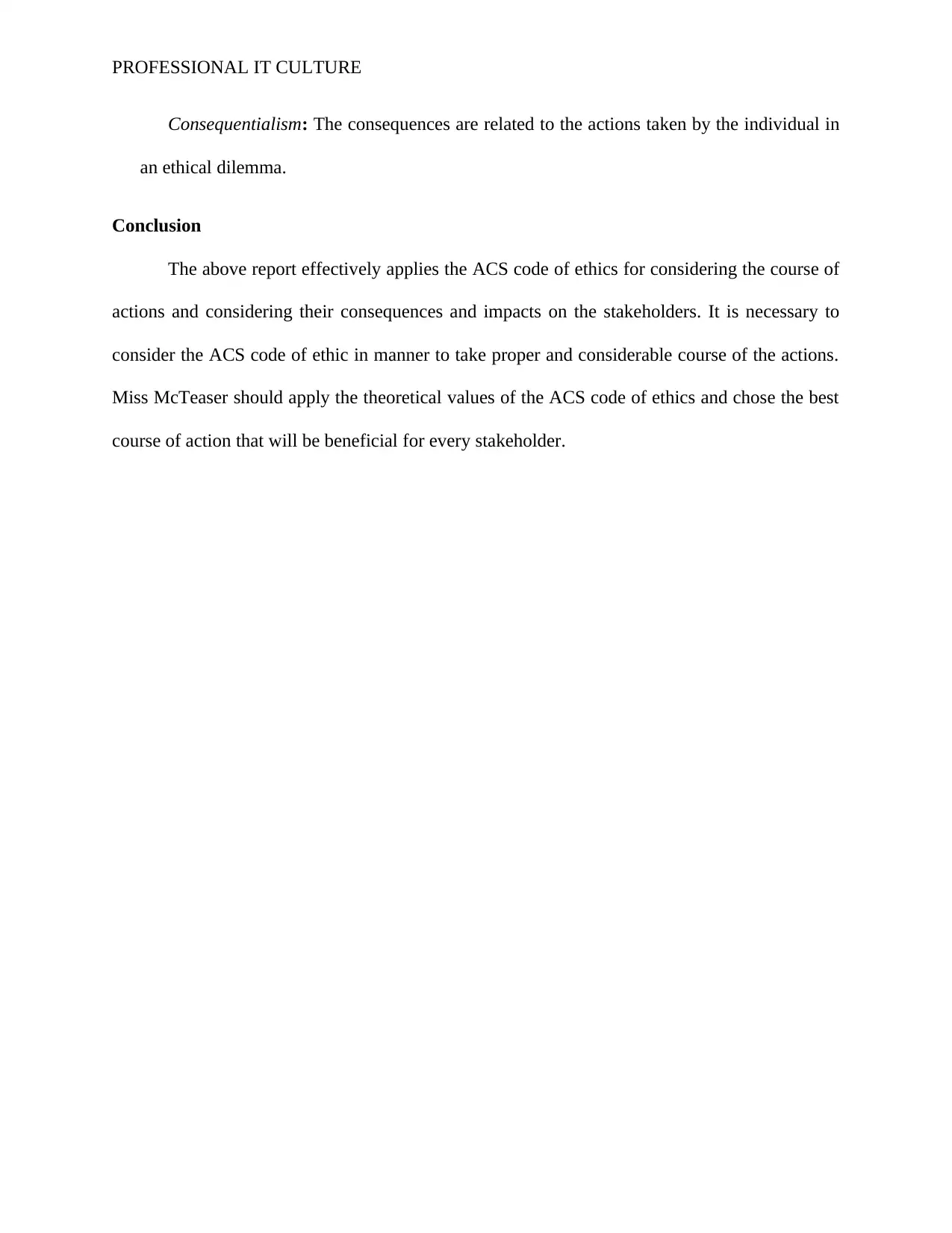
PROFESSIONAL IT CULTURE
Consequentialism: The consequences are related to the actions taken by the individual in
an ethical dilemma.
Conclusion
The above report effectively applies the ACS code of ethics for considering the course of
actions and considering their consequences and impacts on the stakeholders. It is necessary to
consider the ACS code of ethic in manner to take proper and considerable course of the actions.
Miss McTeaser should apply the theoretical values of the ACS code of ethics and chose the best
course of action that will be beneficial for every stakeholder.
Consequentialism: The consequences are related to the actions taken by the individual in
an ethical dilemma.
Conclusion
The above report effectively applies the ACS code of ethics for considering the course of
actions and considering their consequences and impacts on the stakeholders. It is necessary to
consider the ACS code of ethic in manner to take proper and considerable course of the actions.
Miss McTeaser should apply the theoretical values of the ACS code of ethics and chose the best
course of action that will be beneficial for every stakeholder.
Paraphrase This Document
Need a fresh take? Get an instant paraphrase of this document with our AI Paraphraser
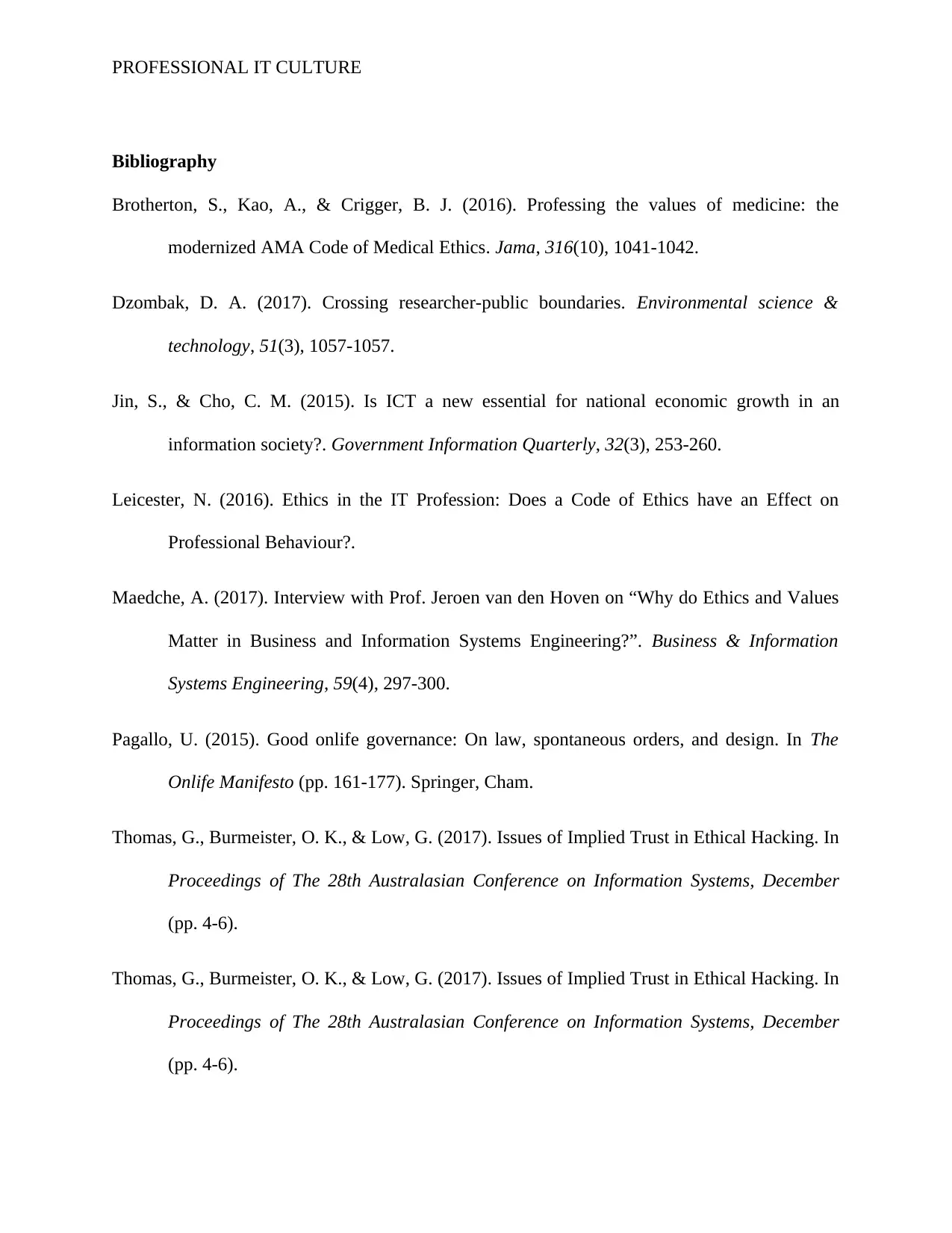
PROFESSIONAL IT CULTURE
Bibliography
Brotherton, S., Kao, A., & Crigger, B. J. (2016). Professing the values of medicine: the
modernized AMA Code of Medical Ethics. Jama, 316(10), 1041-1042.
Dzombak, D. A. (2017). Crossing researcher-public boundaries. Environmental science &
technology, 51(3), 1057-1057.
Jin, S., & Cho, C. M. (2015). Is ICT a new essential for national economic growth in an
information society?. Government Information Quarterly, 32(3), 253-260.
Leicester, N. (2016). Ethics in the IT Profession: Does a Code of Ethics have an Effect on
Professional Behaviour?.
Maedche, A. (2017). Interview with Prof. Jeroen van den Hoven on “Why do Ethics and Values
Matter in Business and Information Systems Engineering?”. Business & Information
Systems Engineering, 59(4), 297-300.
Pagallo, U. (2015). Good onlife governance: On law, spontaneous orders, and design. In The
Onlife Manifesto (pp. 161-177). Springer, Cham.
Thomas, G., Burmeister, O. K., & Low, G. (2017). Issues of Implied Trust in Ethical Hacking. In
Proceedings of The 28th Australasian Conference on Information Systems, December
(pp. 4-6).
Thomas, G., Burmeister, O. K., & Low, G. (2017). Issues of Implied Trust in Ethical Hacking. In
Proceedings of The 28th Australasian Conference on Information Systems, December
(pp. 4-6).
Bibliography
Brotherton, S., Kao, A., & Crigger, B. J. (2016). Professing the values of medicine: the
modernized AMA Code of Medical Ethics. Jama, 316(10), 1041-1042.
Dzombak, D. A. (2017). Crossing researcher-public boundaries. Environmental science &
technology, 51(3), 1057-1057.
Jin, S., & Cho, C. M. (2015). Is ICT a new essential for national economic growth in an
information society?. Government Information Quarterly, 32(3), 253-260.
Leicester, N. (2016). Ethics in the IT Profession: Does a Code of Ethics have an Effect on
Professional Behaviour?.
Maedche, A. (2017). Interview with Prof. Jeroen van den Hoven on “Why do Ethics and Values
Matter in Business and Information Systems Engineering?”. Business & Information
Systems Engineering, 59(4), 297-300.
Pagallo, U. (2015). Good onlife governance: On law, spontaneous orders, and design. In The
Onlife Manifesto (pp. 161-177). Springer, Cham.
Thomas, G., Burmeister, O. K., & Low, G. (2017). Issues of Implied Trust in Ethical Hacking. In
Proceedings of The 28th Australasian Conference on Information Systems, December
(pp. 4-6).
Thomas, G., Burmeister, O. K., & Low, G. (2017). Issues of Implied Trust in Ethical Hacking. In
Proceedings of The 28th Australasian Conference on Information Systems, December
(pp. 4-6).
1 out of 11
Related Documents
Your All-in-One AI-Powered Toolkit for Academic Success.
+13062052269
info@desklib.com
Available 24*7 on WhatsApp / Email
![[object Object]](/_next/static/media/star-bottom.7253800d.svg)
Unlock your academic potential
Copyright © 2020–2025 A2Z Services. All Rights Reserved. Developed and managed by ZUCOL.





